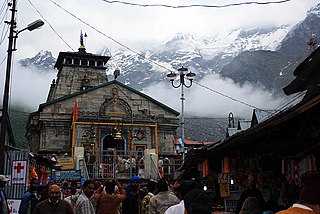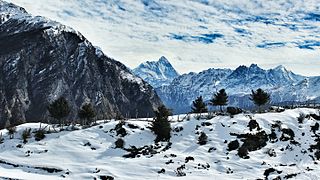Related Research Articles

Makki ki roti also known as makki di roti is a flat unleavened bread made from corn meal, primarily eaten in Pakistan, the Jammu region, Himachal Pradesh, Punjab, Haryana, Rajasthan, Uttar Pradesh, and Uttarakhand in North India and Gujarat, Maharashtra in Western India and also in Nepal. Like most rotis in the Indian subcontinent, it is baked on a tava.

Saag also spelled sag or saga, is a Indian Cuisine leafy vegetable dish eaten with bread, such as roti or naan, or in some regions with rice. Saag can be made from mustard greens, collard greens, basella or finely chopped broccoli along with added spices and sometimes other ingredients, such as chhena.

Garhwal is one of the two administrative divisions of the Indian state of Uttarakhand. Lying in the Himalayas, it is bounded on the north by Tibet, on the east by Kumaon, on the south by Uttar Pradesh state, and on the northwest by Himachal Pradesh state. It includes the districts of Chamoli, Dehradun, Haridwar, Pauri Garhwal, Rudraprayag, Tehri Garhwal, and Uttarkashi. The people of Garhwal are known as Garhwali and speak the Garhwali language. The administrative center for Garhwal division is the town of Pauri. The Divisional Commissioner is the administrative head of the Division, and is a senior Indian Administrative Service officer. As the administrative head of the division, the Commissioner is overall incharge of the 7 districts in the Garhwal region of Uttarakhand, and is aided in his duties by an additional commissioner and the district magistrates. Sushil Kumar is the divisional commissioner of the Garhwal Division since December 2021.

Uttarakhand, formerly known as Uttaranchal, is a state in northern India. The state is bordered by Himachal Pradesh to the northwest, Tibet to the north, Nepal to the east, Uttar Pradesh to the south and southeast, with a small part touching Haryana in the west. Uttarakhand has a total area of 53,483 km2 (20,650 sq mi), equal to 1.6% of the total area of India. Dehradun serves as the state capital, with Nainital being the judicial capital. The state is divided into two divisions, Garhwal and Kumaon, with a total of 13 districts. The forest cover in the state is 45.4% of the state's geographical area. The cultivable area is 16% of the total geographical area. The two major rivers of the state, the Ganges and its tributary Yamuna, originate from the Gangotri and Yamunotri glaciers respectively.

Garhwali is an Indo-Aryan language of the Central Pahari subgroup. It is primarily spoken by over 2.5 million Garhwali people in the Garhwal region of the northern Indian state of Uttarakhand in the Indian Himalayas.

Rajasthani cuisine is the traditional cuisine of the Rajasthan state in north-west India. It was influenced by various factors like the warlike lifestyles of its inhabitants, the availability of ingredients in an arid region and by Hindu temple traditions of sampradayas like Pushtimarg and Ramanandi. Food that could last for several days and could be eaten without heating was preferred.

Ramnagar is a town and municipal board in the Nainital district of Kumaon in the state of Uttarakhand, India. It is located approximately 65 kilometres (40 mi) from Nainital, the headquarters of the district.
Bhojpuri cuisine is a style of food preparation common among the Bhojpuri people of Bihar, Jharkhand and eastern Uttar Pradesh in India, and also the Terai region of Nepal. Bhojpuri foods are mostly mild and tend to be less hot in terms of spices used. The cuisine consists of both vegetable and meat dishes.

Ariselu or Arisa is an Indian sweet from Andhra Pradesh, Odisha, Telangana. It is also called Kajjaya in Kannada, Adhirasam in Tamil Nadu, Neyyappam in Kerala ,Anarsa in Marathi, arsa or anarsa in Uttarakhand, Bihar and Jharkhand.

Jharkhandi cuisine is the cuisine of the Indian state of Jharkhand. Staple foods are rice, dal, roti, and vegetables. Common meals often consist of vegetables that are cooked in various ways, such as curried, fried, roasted and boiled. Many traditional dishes of Jharkhand may not be available at restaurants.

The Garhwali people are an Indian ethnolinguistic group native to the Garhwal, in the Indian state of Uttarakhand, who speak Garhwali, an Indo-Aryan language.
Bihari cuisine is eaten mainly in the eastern Indian state of Bihar, as well as in the places where people originating from the state of Bihar have settled: Jharkhand, Eastern Uttar Pradesh, Bangladesh, Nepal, Mauritius, South Africa, Fiji, some cities of Pakistan, Guyana, Trinidad and Tobago, Suriname, Jamaica, and the Caribbean. Bihari cuisine includes Angika cuisine, Bhojpuri cuisine, Maithil cuisine and Magahi cuisine. Dal Puri

Sarson ka saag, also known as sarsa da saag, is a dish of mustard greens cooked with spices. It originated in the Punjab region and is popular throughout the South Asia.

Papad ki Bhaaji or Papad ka Saag is a vegetarian main course dish made using Papad and is popular in Rajasthani, Gujarati, Bundeli, Malwi, Nimadi and Braj cuisines. The dish is prepared with many variations and is also known by the name Papad ro saag in Rajasthani and Papad nu shaak in Gujarati. Papad ki bhaaji can be easily prepared with few basic ingredients at home and without the need of any vegetable. Hence it typifies the simple food that one needs for sustenance amidst the hardship of desert life.
Chander Singh Rahi was a prominent folk singer, balladeer, musician, poet, storyteller, and cultural conservator from Uttarakhand, India.
Cuisines and food of the Indian state of Haryana is known to be simple. People of the state prefer their food to be made with fresh ingredients and through simple recipes. Roti is a staple food in Haryana, made from a variety of grains and flour. Since Haryana is rich with agriculture and cattle, the use of dairy products is abundant in their food. Many households churn fresh butter from milk and use it as opposed to the butter available in the markets. Lassi is a popular and staple drink in Haryana. The food in Haryana finds a lot of similarities with its neighboring states Punjab and Rajasthan.
Consumption of non-vegetarian food is generally avoided in the state and sometimes is even considered a taboo among the rural population.
Jwalpa Devi Temple is a shrine dedicated to the goddess Jwalpa, a form of goddess Parvati. It's situated on the bank of Nawalika River, 34 km from Pauri on the main Pauri-Kotdwar road.
Shiv Prasad Dabral, known by his pen name Charan, was an Indian historian, geographer, academic and writer from Uttarakhand. He is also known as 'Encyclopedia of Uttarakhand'. He started writing from 1931 onwards. He is the author of the monumental history of Uttarakhand in 18 volumes, 2 collections of poetry, 9 plays, and several edited volumes in Hindi and Garhwali. His Uttarakhand ka Itihaas is widely used by scholars as reference work. He authored several books on the archeology and ecology of Uttarakhand. To his credit, Charan saved 22 rare books of Garhwali language from extinction by republishing them at his own press. He also rediscovered a rare poetry manuscript of Mola Ram.
Bironkhal Tehsil is a administrative division located in the Pauri Garhwal district of the Indian state of Uttarakhand. It is one of the 14 tehsils in the district and is headquartered in the town of Syunsi. It was created in 2016 with 367 villages taken from Dhumakot, Chaubattakhal and Thalisain tehsils. The main languages spoken in the area are Hindi and Garhwali.
References
- ↑ "Uttarakhand Food: , A Beginner's Guide to the Cuisines of Kumaon and Garhwal". NDTV Food. Retrieved 2019-09-03.
- ↑ Ankit (2019-06-12). "Arsa - Story of A Dish Which Relates Uttarakhand & South India in 9th Century". WildHawk. Retrieved 2022-08-02.
- ↑ "How to make Garhwal Ka Fannah Recipe". Slurrp. Retrieved 2022-08-12.
- ↑ "Ever Heard of Garhwali Delight Phaanu?". Slurrp. Retrieved 2022-10-25.
- ↑ "Kafuli: This Saag Is The State Food Of Uttarakhand, Tried Yet?". Slurrp. Retrieved 2022-08-11.
- ↑ Live, A. B. P. (2022-09-30). "Video: यहां बनाई जाती है बिच्छू की तरह डंक मारने वाले पौधे की सब्जी, क्लासिक डिश में है शुमार". www.abplive.com (in Hindi). Retrieved 2022-10-01.
- ↑ "Cuisines Archives | Uttarakhand Tourism Development Board | Department of Tourism, Government Of Uttarakhand, India". | Uttarakhand Tourism Development Board | Department of Tourism, Government Of Uttarakhand, India. Retrieved 2019-09-03.
- ↑ Rao, Tulsi (2022-09-02). "घर पर बनाए रोटाना मिठाई, जानें बनाने का तरीका". jantaserishta.com (in Hindi). Retrieved 2022-09-02.